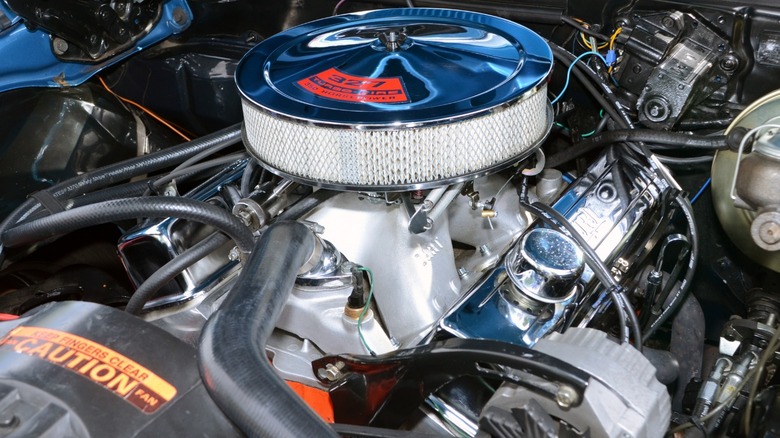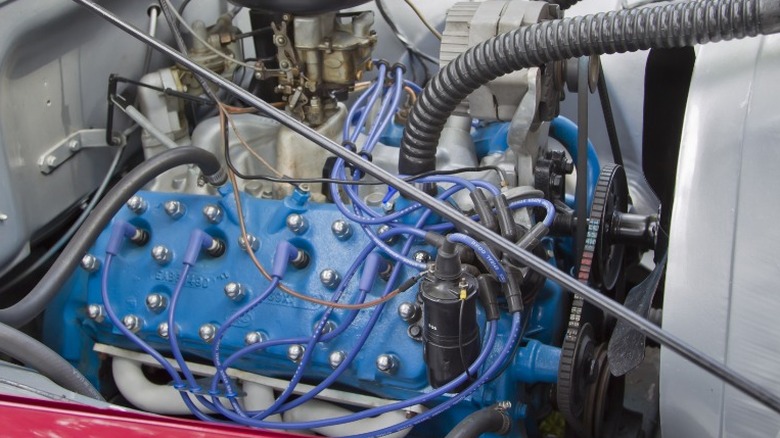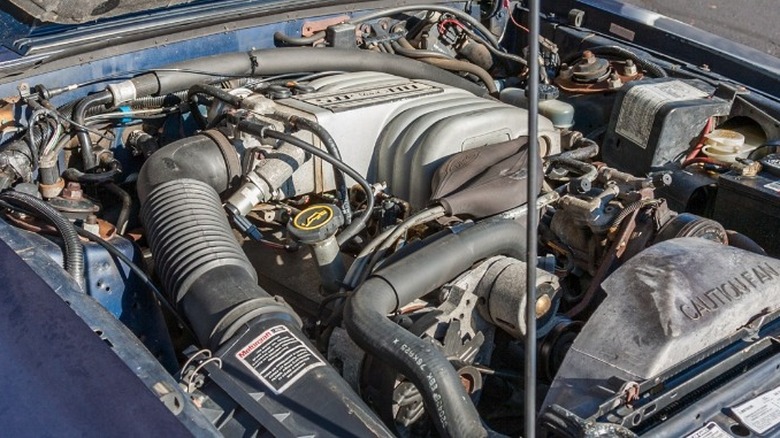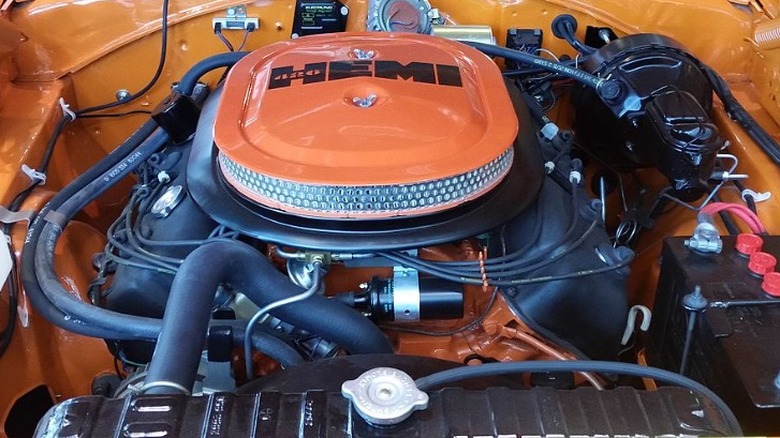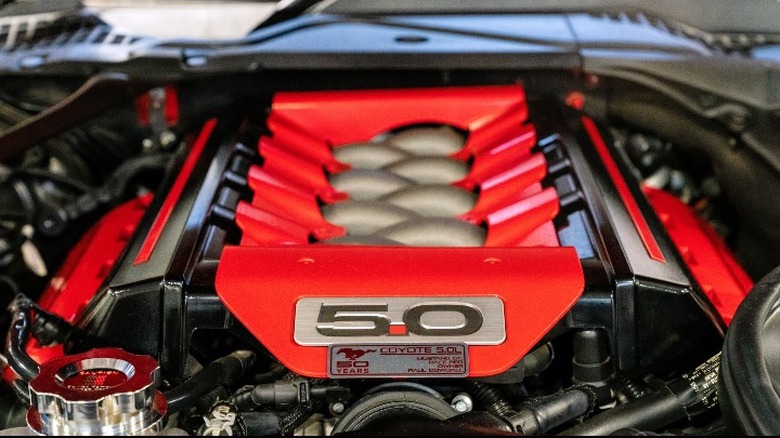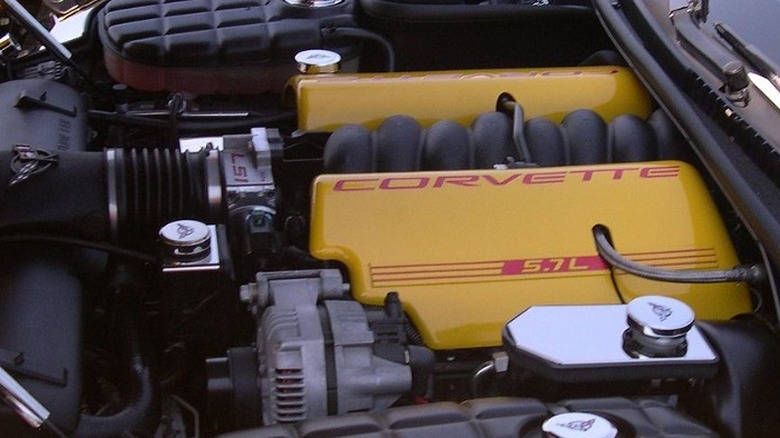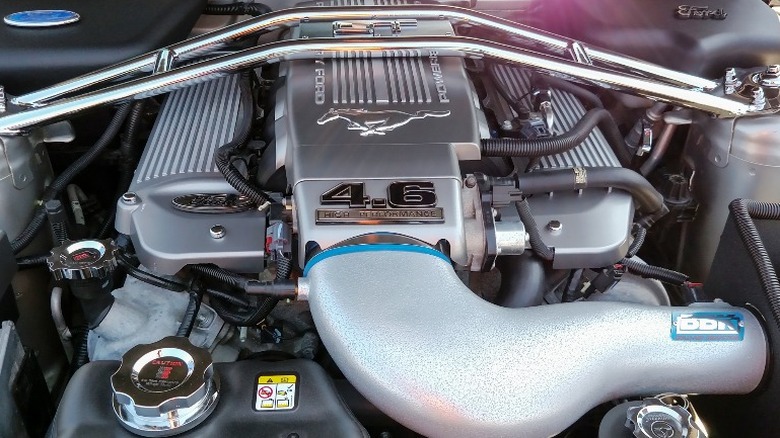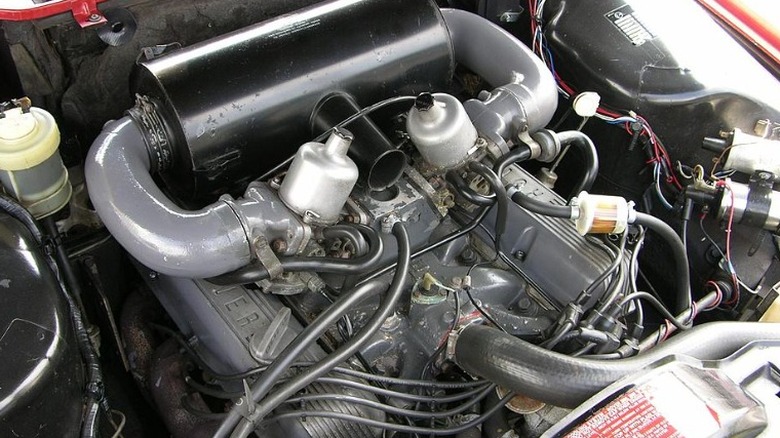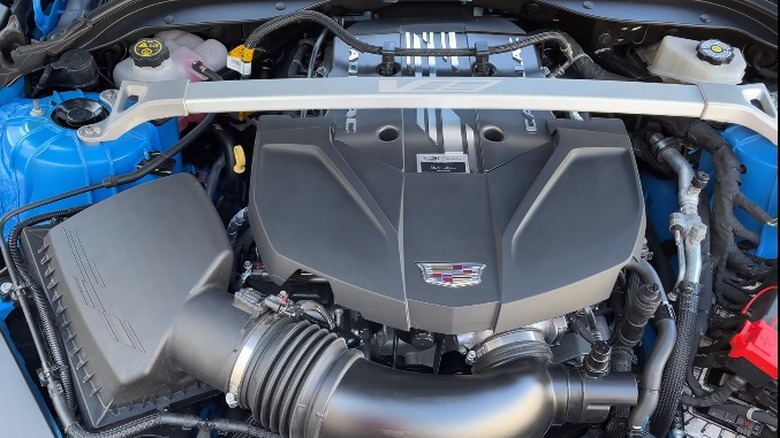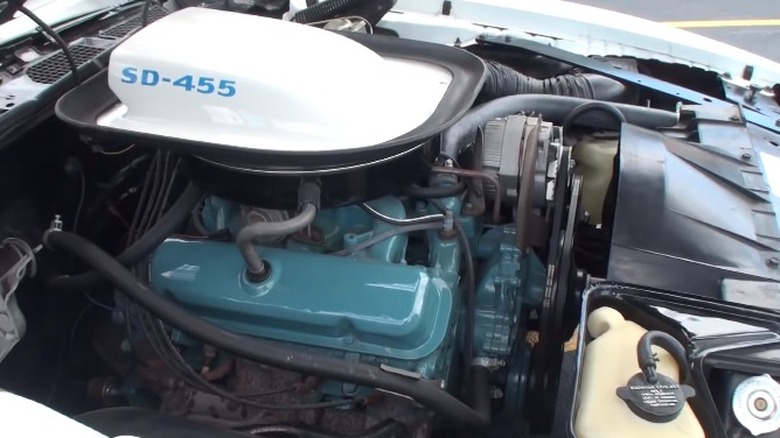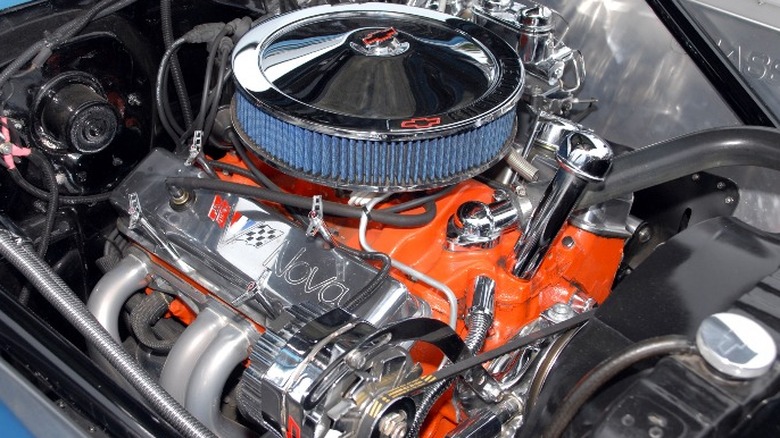The 10 Greatest American V8 Engines Ever Made
Many things define The United States of America. Apple pie and the Statue of Liberty, for example, while petrolheads might say it is the mighty American V8 engine, a symbol of American power. The Italians have a lock on the V12 market and the Germans still hold true to their stout inline sixes, but the affection for the V8 in the New World can be traced back to the 1930s with Henry Ford's flathead V8 (via Curbside Classic).
Ford did not invent the V8 engine and it wasn't the only company in the U.S. to create one, but it was the only company to push out V8-equipped cars en masse until the 1950s when everyone else in Detroit began to catch up. Once that ball got rolling, it picked up steam quickly and the V8 became the standard in the market, making up a huge share of cars sold, with 4- and 6-cylinder cars being reserved only for the most economical choices. As the years rolled on, every American manufacturer had several V8 engines on offer, including perennial underdog American Motors Corporation and Studebaker, both of which are now defunct. In the modern world of increasing efficiency, stringent emission controls, and electric mobility, the V8 is a dying breed. So, before we write the epitaph of the mighty American V8, let's have a look at the 10 best to date.
Ford Flathead
The 1932 Ford Flathead got the 8-cylinder party started when it was offered across the line in its automobiles and trucks (via Motor Trend). The first documented V8 engine came from France, the Antoinette aircraft and speedboat engine, per Auto Evolution. Others followed on both sides of the Atlantic, but when Ford needed a shot in the arm to bring business back after retiring the Model T and failing to see the same success with the Model A, it made a V8 for the masses.
Ford first sold cars equipped with the flathead V8 in 1932 along with a brand-new car design. The first models came with a displacement of 221 cubic inches and they produced just 65 horsepower, which was a marked improvement over the approximately 40 horsepower delivered by Model T engines (via Enginelabs). While the Flathead continued to be developed throughout its production run, it proved to be a robust power plant and it sold well. The engine design is highly inefficient compared to modern engines, but its strengths came from the fact that it was simple and robust. Making the engine easy to repair and with certain engineering choices that made it strong, such as using timing gears instead of a chain, kept these going and built a good reputation over the 20 years of production, according to Road and Track.
Ford Windsor 5.0
After its initial success in building V8 engines for the masses, Ford has continuously updated and improved its engine offerings. The first of the Windsor engine family, named for the Windsor, Canada engine plant, debuted in 1961, starting with a size of 221 cubic inches (3.6-liter). The first of the 302-cubic-inch engines, later to be officially called 5.0-liter, arrived in 1968 to coincide with the start of the then-new Trans Am racing series, which had a maximum displacement rule of 302 cubic inches. Among the special cars receiving this block were the legendary Shelby GT350 and the Boss 302, per Driving Line. Ford continued to build this size V8 for many years, with it becoming the base V8 option for a wide range of cars.
A push towards the usage of the metric system prompted Ford to change its designation to liters around the same time as it released the Fox Body Mustang. Although widespread adoption of the metric system never caught on in the U.S., auto manufacturers started a complete changeover at this time. Thus, the new favorite V8 of Ford enthusiasts became the venerable 5.0, particularly in its H.O. (High Output) form. In 1984 a fuel-injected H.O. 5.0 Ford ruled the streets and became the must-have engine of the decade, with Fox Body Mustangs being wildly popular and retaining their appeal today.
Chrysler 426 HEMI
During the heated "horsepower wars" of the late '60s, the Chrysler 426 Hemi was generally the engine everyone wanted to beat. Its sheer size and clever design led to an extremely high amount of power being squeezed out of this engine. While Chrysler is best known for producing engines using a hemispherical combustion chamber, the first implementation of it came in 1905 from a Belgian company, according to Motor Trend. Chrysler released its renowned HEMI engines after WWII.
In 1964, Chrysler started offering a HEMI engine with a displacement of 426 cubic inches, one of the largest engines ever offered, Motor Trend notes. The 426 was originally created to power Chrysler cars in NASCAR racing and was so successful and popular, the company decided to offer it in production vehicles, especially since NASCAR banned the engine in 1965, citing unfair power advantage. Street-legal versions of it were detuned for passenger cars, yet still put out an impressive 425 horsepower. While the HEMI went on to be a street car legend and highly desirable for many muscle car builds, the last of them left the factory in 1971 as a bevy of new regulations significantly slowed down the automakers.
[Featured image by Steven Kevil via Wikimedia Commons | Cropped and scaled | CC BY-SA 4.0]
Ford Coyote
One of Ford's newest engines takes advantage of many technology updates over the past couple of decades to propel the latest Mustangs to speed with vast amounts of power. Ford unleashed its Coyote in 2011 and put a 5.0 in the Mustang after a hiatus of a decade or so. Despite being classified as one of Ford's modular engines, it was an all-new design when it first appeared, and came equipped with Twin Independent Variable Cam Timing (Ti-VCT) and an extremely high compression ratio of 11:1, according to Motor Trend. The Ti-VCT is probably the most important development of this engine, as it can adjust the timing on both intake and exhaust cams independently, a first for a V8 engine. The technical details are a bit wonky, but the engine helps generate significant power while maintaining excellent efficiency.
The legacy of the Coyote is that it gave us some of the most powerful Mustangs ever. In its stock form from the factory, it can produce up to 460 horsepower. However, in the hands of tuners like Roush and Shelby, the limits go much higher. Hennessey, for example, offers an upgrade to current Mustang GTs that boosts output to an astonishing 800 horsepower with 677 pound-feet of torque. As a bonus, Hennessey offers a 3-year/36,000-mile warranty for worry-free tire shredding.
Chevrolet LS1
Chevrolet engine designations have for many years begun with the letter L, followed by various letters and numbers to signify a particular engine. One of the most popular and well-known Chevy V8 engines among those who tune and build them is the LS1. Originally installed in the 1997 Chevrolet Corvette, according to GM Authority, the LS1 used some of the base architecture and design from the decades-old small-block Chevy and updated it with significant alterations throughout. The first Corvette arrived at dealers with 345 horsepower, a figure not seen since the late '60s, and the next year it found its way to Camaros and Firebirds.
While the LS1 is a great engine just as it came in cars from the factory, what makes it really great is what was done with it later. An engine swap so common it has become a meme, dropping an LS1 V8 into just about any chassis from ancient economy boxes to a Porsche 911 is something of a rite of passage for serious custom shops. A couple of nice examples of such a transplant can be found in a Petrolicious feature with a swapped vintage BMW that now possesses about 448% (a very rough estimate) more torque than stock, or the excellent example of squeezing eight cylinders of fire under the hood of a fourth-gen Miata as a testament to just how crazy it can get.
[Featured image by Sfoskett via Wikimedia Commons | Cropped and scaled | CC BY-SA 3.0]
Ford Modular 4.6
After Ford successfully integrated multi-port fuel injection into its 5.0 Windsor V8, the replacement stepped up the technology another rung on the ladder by adding overhead cams, a rarity among American V8 engines that persists today. The beastly Hellcat engines from Dodge and even the ultra-powerful C8 Corvette engines both rely on the old pushrod tech, but Ford moved the camshafts up top back in 1990 with its new Modular series of engines.
The Modular 4.6, according to Ford Authority, first appeared in the Lincoln Town Car and went on to power a variety of larger cars and light trucks, such as the Crown Victoria, F-150, Thunderbird, Explorer, and Continental. In its base configuration, it is good for a modest 190 horsepower but delivers a healthy 260 pound-feet of torque, which is good for getting heavier cars down the road. Developments in engineering and technology saw increases in power and efficiency, with dual-cam versions able to pack the most punch. The best-performing Ford with this engine is the Mustang SVT Cobra, with a supercharged 390 horsepower in 2003.
Ford's 4.6 has proven to be a reliable and capable engine, but the most impressive vehicle it has ever been installed in is a Koenigsegg. According to Motor Biscuit, the first dozen or so cars made by the Swedish hypercar sensation were highly modified versions of a Ford V8, however, in this setup, power output rose to 806 horsepower, proving just how robust and capable the Ford Modular can be.
Buick 215
Fans of American muscle cars may not be enthusiastic about the Buick 215, which was also seen in Oldsmobiles and Pontiacs (via Museum of American Speed). It is a smaller V8 and never saw use in any of the most prominent muscle cars like a GTO or Chevelle. American muscle cars, especially in the late '60s, used generally 5.0-liter engines and up, while the 215 is just 3.5. So it might seem odd to talk about it as a best engine, right?
What makes the Buick 215 special is the life it led after leaving GM. When the engine was retired, the rights, blueprints, and tooling were sold to Rover in the U.K, according to Petrolicious. Having received everything needed to manufacture this V8, Rover set about to upgrade it in many ways particular to their range of cars and it ended up being one of the longest-lasting production runs of any engine on the island.
After Rover bought the rights to the engine, it was slated to power the new P6, a luxury saloon intended for British roads. The new Rover V8 eventually went into the P5 and P6 models to great acclaim. It later found its way into a variety of Rovers and other British cars like TVR, Triumph, and Morgan, per Autocar. But its greatest application was the Land Rover, and production endured for 50 years, ending as recently as 2017.
Cadillac Blackwing
For decades, Cadillac has been known as the car of choice for retirees to ride to Sunday morning service. Sure, Cadillac made an impressive V16 for a few years in the '30s, but it became a company that sold sofas with wheels by the '80s. Seeing the success of the German sports sedans with powerful engines and tight handling, someone at GM gave Cadillac a kick in the pants and started making exciting cars, like the CTS-V and XLR. This effort culminated in the production of perhaps the greatest Cadillac engine ever, the Blackwing V8.
Amazingly, Cadillac has made an engine to compete with the best sedans hailing from Germany. Done just before the company was to flip the switch changing to an all-electric manufacturer, Cadillac gave us a twin-turbo 4.3-liter twin-cam V8 that makes a spectacular 550 horsepower. The Drive says this 550 horsepower screamer uses small turbos mounted in the valley to reduce lag to a minimum and, perhaps more important than the horsepower, its torque rating is a thunderous 627 pound-feet, which will almost launch a luxury sedan to space, or at least feel like it.
The most recent car this is found on is the CT5-V Blackwing, America's best example of what a luxury sports sedan can be. Also unique for a Cadillac, this amazing engine is paired with a six-speed manual, something not seen in Cadillacs since automatic transmissions were invented.
Pontiac 455 Super Duty
At the peak of the muscle car horsepower wars, Pontiac unleashed the behemoth 455 Super Duty V8. Before GM mandated parts sharing among the brands, forcing them to share engines across many different makes within the company, each division largely made its own engines. Even though Pontiac, Buick, and Oldsmobile all produced 455-cubic-inch engines, they were all different from each other. But the Pontiac 455 SD may have been the best among the bunch.
The late '60s saw brinkmanship among automakers pushing the size of their engines to ludicrous heights. Pontiac's displacement peaked with its 455 V8 when it came out in 1970, per Driving Line. With emissions regulations and the malaise era not yet taking hold, Pontiac was free to beef up this block to also make ludicrous power. Pontiac offered its 455 with a choice of 2-bolt or 4-bolt main bearing caps, the latter used on the Super Duty (SD) option. With the SD engine, ample power was made as it produced up to 370 horsepower and a gargantuan 500 pound-feet of torque, which could easily launch a tank.
The 1970s brought about seismic shifts and fundamental changes to the ways automobiles are made. Big block engines were relegated to powering land barges that needed the torque and muscle cars all but disappeared. But Pontiac held out, manipulating legal loopholes to keep a slightly detuned 455 H.O. V8 in the Trans Am until 1974, marking the end of an era.
Small Block Chevy
Chevrolet hit its first mass-produced V8 out of the park. The original 283 installed on the 1955 Bel Air made an impression on buyers and cemented Chevrolet's place as a competitive car company, as it had only offered 6-cylinder inline engines up until then. Autocar said the new engine, though modestly powered, attracted more affluent buyers to the brand and sales took off.
The new small block engine grew in size throughout the '60s, leaving its mark on the street and the track. The mainstay of Chevrolet during this period was the 327, which powered Chevelles, Novas, and some of the best-looking Corvettes of the period. Horsepower also shot up until the 350 arrived around 1968 and would remain the default engine for sports cars and heavy-duty applications for the remainder of the century.
The strengths of the small block Chevy that allowed it to dominate for almost half a century are its simplicity of design and robust block casting. Hagerty explains that the original design utilized casting processes that delivered an extremely strong block but also required fewer resources to create, making it much cheaper to produce. This resulted in an engine that could be mass-produced and put in affordable cars, and the simplicity of its design also made it easy to service and repair, making it the engine of choice for hobbyists and racers everywhere. All these reasons combine for a compelling argument that the small-block Chevy is the best American V8 of all time.
